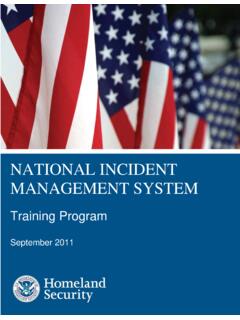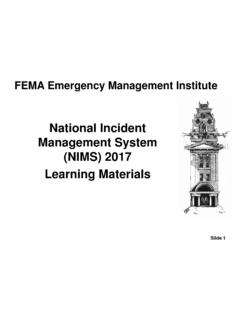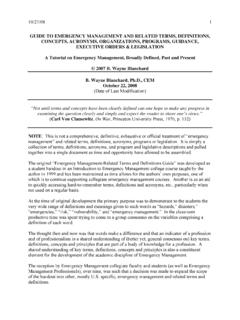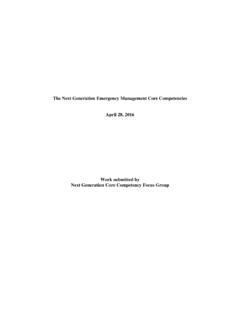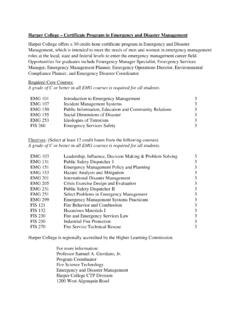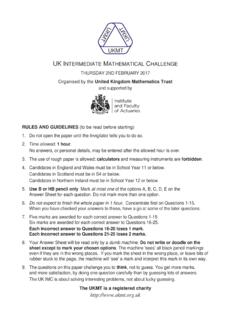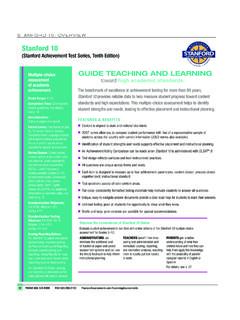Transcription of Incident Action Planning Process - Emergency Management …
1 Incident Action Planning Process The Planning P EXTRACTED FROM - E/L/G 0300 intermediate Incident COMMAND SYSTEM FOR EXPANDING INCIDENTS, ICS 300 March 2018 Incident Action Planning Process EXTRACTED FROM - E/L/G 0300 intermediate Incident Command System for Expanding Incidents, ICS 300 2 Incident Action Planning Process The Incident Action Planning Process and IAPs are central to managing incidents. The Incident Action Planning Process helps synchronize operations and ensure that they support Incident objectives. Incident Action Planning is more than producing an IAP and completing forms it provides a consistent rhythm and structure to Incident Management . Personnel managing the Incident develop an IAP for each operational period. A concise IAP template is essential to guide the initial Incident Management decision Process and the continuing collective Planning activities.
2 The IAP is the vehicle by which leaders on an Incident communicate their expectations and provide clear guidance to those managing the Incident . The IAP: Informs Incident personnel of the Incident objectives for the operational period, the specific resources that will be applied, actions taken during the operational period to achieve the objectives, and other operational information ( , weather, constraints, limitations, etc.); Informs partners, EOC staff, and MAC Group members regarding the objectives and operational activities planned for the coming operational period; Identifies work assignments and provides a roadmap of operations during the operational period to help individuals understand how their efforts affect the success of the operation; Shows how specific supervisory personnel and various operational elements fit into the organization; and Often provides a schedule of the key meetings and briefings during the operational period.
3 The IAP provides clear direction and includes a comprehensive listing of the tactics, resources, and support needed to accomplish the objectives. The various steps in the Process , executed in sequence, help ensure a comprehensive IAP. These steps support the accomplishment of objectives within a specified time. The development of IAPs is a cyclical Process , and personnel repeat the Planning steps every operational period. The Operational Period Planning Cycle ( Planning P) is a graphic depiction of this cycle. Personnel develop the IAP using the best information available at the time of the Planning Meeting. Personnel should not delay Planning meetings in anticipation of future information. In the Planning P, the leg of the P describes the initial stages of an Incident , when personnel work to gain awareness of the situation and establish the organization for Incident Management .
4 March 2018 Incident Action Planning Process EXTRACTED FROM - E/L/G 0300 intermediate Incident Command System for Expanding Incidents, ICS 300 3 During the initial stage of Incident Management , the Incident Commander typically develops a simple plan and communicates the plan through concise oral briefings. In the beginning of an Incident , the situation can be chaotic and situational awareness hard to obtain, so the Incident Commander often develops this initial plan very quickly and with incomplete situation information. As the Incident Management effort evolves, additional lead time, staff, information systems, and technologies enable more detailed Planning and cataloging of events and lessons learned. The steps of the Planning Process are essentially the same for the first responders on scene determining initial tactics and for personnel developing formal written IAPs.
5 Incident personnel perform the steps in the leg of the P only one time. Once they are accomplished, Incident Management shifts into a cycle of Planning and operations, informed by ongoing situational awareness and repeated each operational period The following are brief descriptions of the meetings and briefings that are repeated each operational cycle until the conclusion of the Incident or event. Objectives Development/Update: The IC/UC establishes the Incident objectives for the initial operational period. After the initial operational period, the IC/UC reviews the Incident objectives and may validate them, modify them, or develop new objectives. Strategy Meeting/Command and General Staff Meeting: After developing or revising the Incident objectives, the IC/UC typically meets with the Command and General Staff, and sometimes others, to discuss the Incident objectives and provide direction.
6 Preparing for the Tactics Meeting: Once the approach to achieving or working toward achieving the Incident objectives is determined, the Operations Section Chief and staff prepare for the Tactics Meeting by developing tactics and determining the resources that will be applied during the operational period. Tactics Meeting: In the Tactics Meeting, key players review the proposed tactics developed by the Operations Section and conduct Planning for resource assignments. The OPS Section Chief leads the Tactics Meeting, and key participants include the LOG Section Chief, Safety Officer, a Planning representative and others invitees. Preparing for the Planning Meeting: Following the Tactics Meeting, staff collaborate to identify support needs and assign specific resources to accomplish the plan. Planning Meeting: The Planning Meeting serves as a final review and approval of operational plans and resource assignments developed during and after the Tactics Meeting.
7 At the end of the Planning Meeting, Command and General Staff confirm that they can support the plan. March 2018 Incident Action Planning Process EXTRACTED FROM - E/L/G 0300 intermediate Incident Command System for Expanding Incidents, ICS 300 4 IAP Preparation and Approval: Based on concurrence from all elements at the end of the Planning Meeting, the Incident Commander or Unified Command approves the plan. Operational Period Briefing: Each operational period starts with an Operational Period Briefing. Incident supervisory and tactical personnel receive the IAP during the briefing. Members of the Command and General Staff present the Incident objectives, review the current situation, and share information related to communications or safety. Following the Briefing, supervisors brief their assigned personnel on their respective assignments.
8 Operational Period Planning Cycle ( Planning P)

